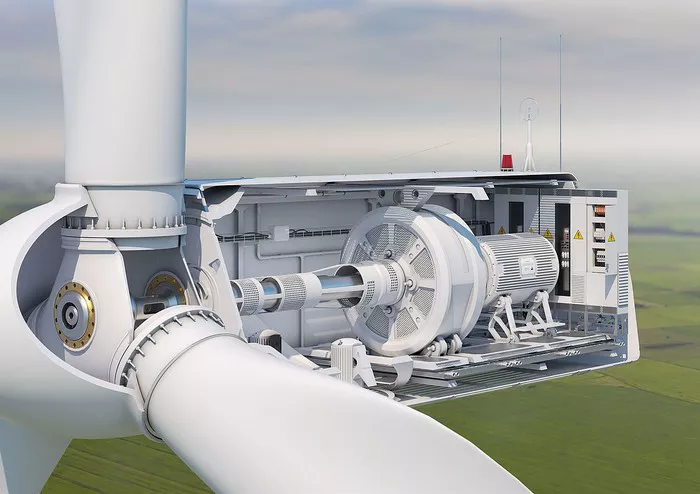Wind energy is one of the most sustainable and rapidly growing sources of renewable energy in the world. At the core of this green revolution are wind turbines, which convert wind energy into electricity. But how do wind turbines work? What are their types, applications, and benefits? This article will provide a comprehensive understanding of wind turbines, their working principles, types, advantages, and challenges.
How Does A Wind Turbine work
Wind turbines generate electricity by harnessing the kinetic energy of the wind. The process involves several steps:
Wind Capture: Wind moves across the blades of a turbine, causing them to rotate.
Mechanical Energy Conversion: The rotation of the blades turns a shaft connected to a gearbox, which increases the rotational speed.
Electrical Energy Generation: The gearbox drives a generator that converts mechanical energy into electrical energy.
Power Distribution: The generated electricity is transferred through power lines and distributed for use in homes, businesses, and industries.
The amount of electricity generated depends on wind speed, turbine size, and air density. Modern wind turbines can start operating at wind speeds as low as 3-4 m/s (meters per second) and shut down at very high speeds (typically above 25 m/s) to prevent damage.
Types of Wind Turbines
Wind turbines are categorized based on their axis of rotation and other design factors:
1. Horizontal-Axis Wind Turbines (HAWTs)
These are the most common type of wind turbines, typically seen in wind farms. They have blades that rotate around a horizontal axis and are mounted on tall towers to capture stronger winds.
Advantages:
- Higher efficiency compared to vertical-axis turbines
- Well-established technology with proven reliability
- Capable of generating large amounts of electricity
Disadvantages:
- Requires a tall tower and large foundation
- High maintenance costs due to complex components
2. Vertical-Axis Wind Turbines (VAWTs)
These turbines have blades that rotate around a vertical axis and are less common than HAWTs. They are typically used in urban environments and areas where wind direction changes frequently.
Advantages:
- Can operate in turbulent wind conditions
- Easier to maintain as the generator is located closer to the ground
- Requires less space compared to HAWTs
Disadvantages:
- Generally less efficient than HAWTs
- More susceptible to mechanical stress and wear
Components of a Wind Turbine
A wind turbine consists of several key components:
Blades: Capture wind energy and convert it into rotational motion.
Rotor: Comprises the blades and the central hub; rotates as wind blows.
Nacelle: Houses essential components like the gearbox, generator, and control systems.
Gearbox: Increases the rotational speed to generate electricity efficiently.
Generator: Converts mechanical energy into electrical energy.
Tower: Provides height for better wind capture and supports the turbine structure.
Control System: Monitors and adjusts turbine operations for optimal performance.
Yaw Mechanism: Ensures the turbine faces the wind for maximum efficiency.
Applications of Wind Turbines
Wind turbines have various applications, ranging from small-scale residential use to large-scale power generation. Some common applications include:
Utility-Scale Wind Farms: Large groups of wind turbines used to supply electricity to the grid.
Offshore Wind Farms: Wind turbines installed in bodies of water to harness strong, consistent wind energy.
Distributed Generation: Small-scale wind turbines used for homes, farms, and remote areas.
Hybrid Systems: Combined with solar panels or battery storage to provide reliable power in isolated locations.
Advantages of Wind Turbines
Wind turbines offer numerous environmental and economic benefits, making them a preferred choice for clean energy generation:
Renewable Energy Source: Wind is an abundant and inexhaustible energy resource.
Reduces Carbon Emissions: Producing electricity from wind reduces greenhouse gas emissions.
Cost-Effective in the Long Run: Although initial setup costs are high, operational costs are low.
Energy Independence: Wind energy reduces reliance on fossil fuels and enhances energy security.
Job Creation: The wind energy sector provides employment opportunities in manufacturing, installation, and maintenance.
Challenges and Limitations
Despite its many benefits, wind energy has some challenges:
Intermittent Nature: Wind energy production depends on wind availability, requiring backup power sources.
High Initial Investment: The cost of turbines, installation, and grid connection can be expensive.
Aesthetic and Noise Concerns: Some communities oppose wind farms due to their visual impact and noise.
Wildlife Impact: Wind turbines can pose risks to birds and bats, requiring careful site selection and mitigation measures.
Land Use Conflicts: Large wind farms require significant land, which may conflict with other land uses.
Conclusion
Wind turbines play a crucial role in the global transition to renewable energy. They offer clean, sustainable power while reducing dependence on fossil fuels. Despite challenges such as intermittency and high initial costs, ongoing advancements continue to make wind energy more efficient and accessible. As technology improves, wind turbines will remain an essential part of the world’s energy landscape, helping to combat climate change and promote a greener future.

